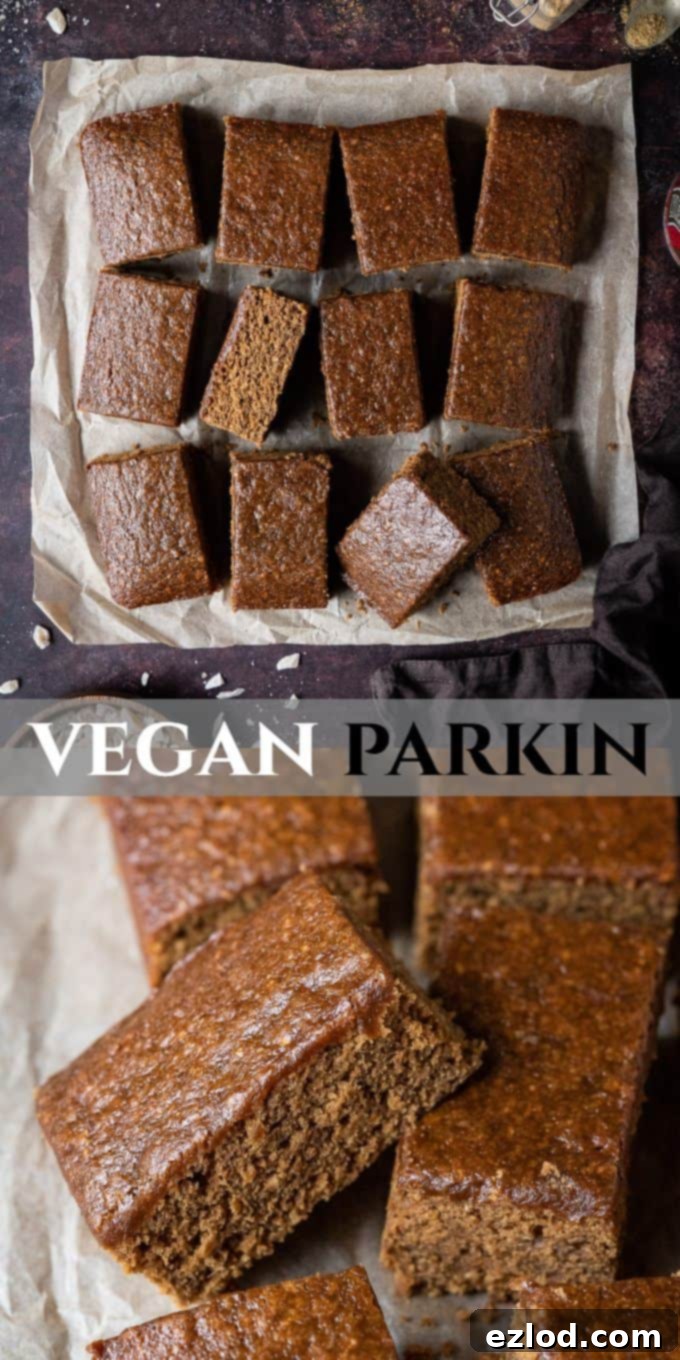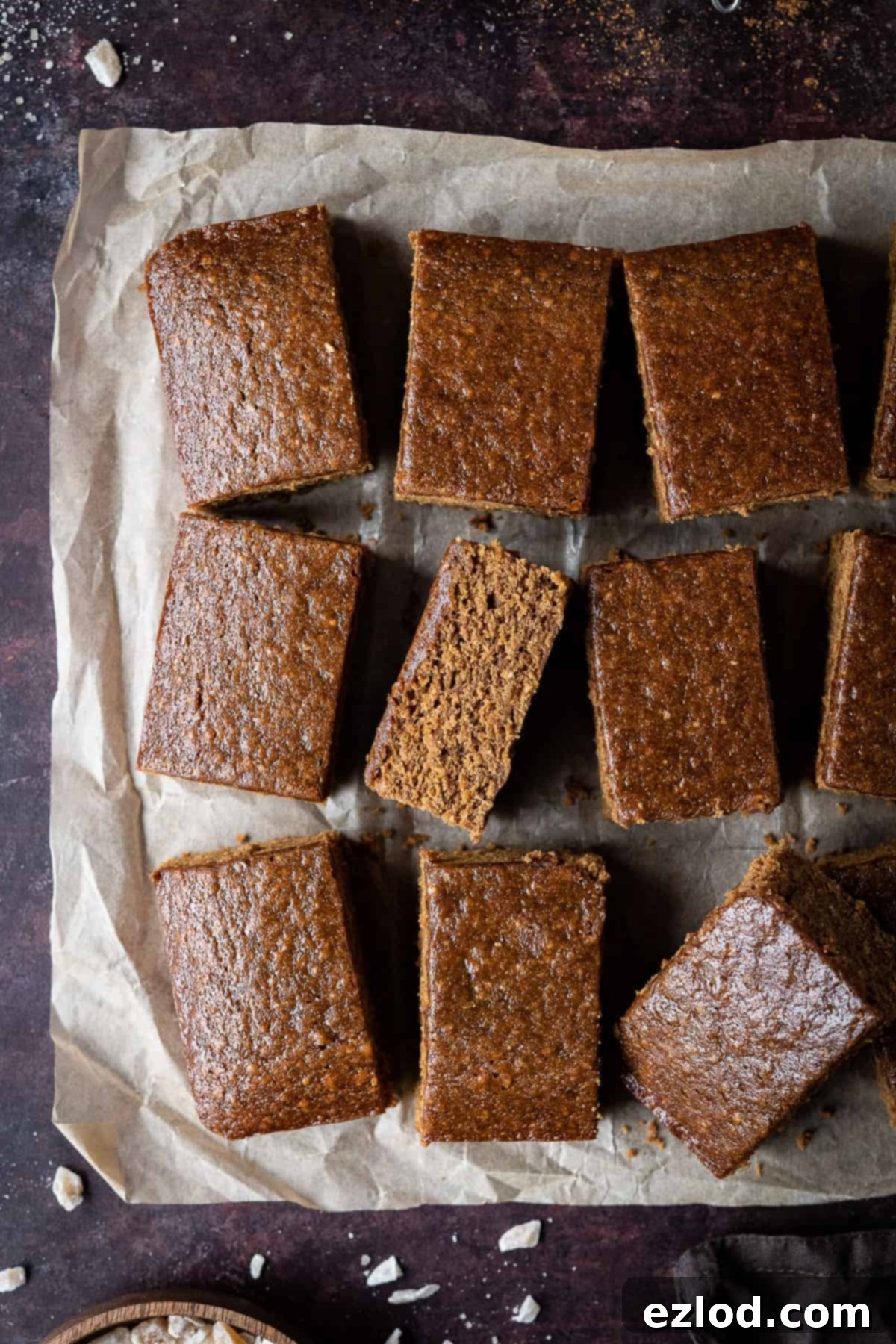The Ultimate Vegan Parkin Recipe: A Sticky, Spicy Oatmeal Ginger Cake
Discover the joy of this vegan parkin – a rich, sticky, and intensely spiced ginger cake made with wholesome oatmeal. This classic Yorkshire treat is incredibly easy to prepare, irresistibly moreish, and the perfect warming delight for Bonfire Night or any chilly evening. Our recipe is proudly eggless and dairy-free, ensuring everyone can enjoy a slice of traditional comfort.
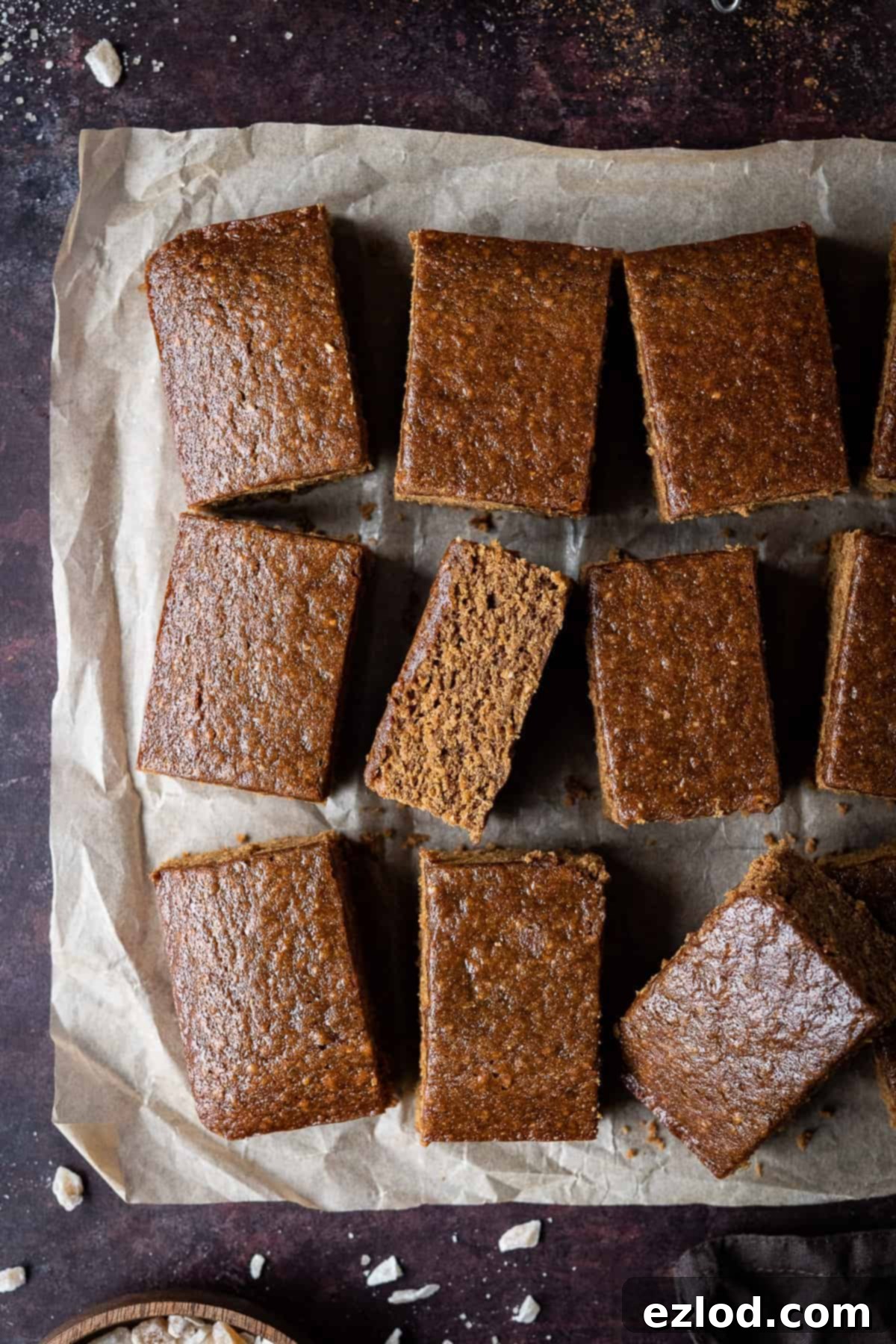
This vegan parkin recipe brings you a gloriously sticky, spicy ginger cake that’s not only a breeze to make but also astonishingly delicious. It’s the quintessential cold-weather indulgence, designed to warm you from the inside out with its deep, comforting flavors.
Thanks to the incorporation of ground oats, this parkin boasts a denser, more substantial texture than your average ginger cake. This makes it a wonderfully hearty and satisfying snack, ideal for fueling brisk winter walks or keeping you toasty while gathered around a crackling bonfire on Guy Fawkes Night. Imagine pairing a thick slice with a steaming mug of tea – pure bliss!
What Exactly Is Parkin? Exploring This Traditional British Cake
Parkin is a time-honored ginger cake with deep roots in the culinary traditions of Northern England, specifically Yorkshire and Lancashire. While it’s enjoyed throughout the colder months, it holds a special place as a traditional treat for Bonfire Night (November 5th).
The defining characteristic that sets parkin apart from other ginger cakes is its inclusion of oats, typically medium oatmeal. This key ingredient contributes to its signature dense, slightly chewy texture and helps create that wonderful sticky consistency as it ages. Historically, parkin was often baked into a firm slab, then wrapped and stored for a week or more before serving. This “curing” process allowed the flavors to deepen and the cake to soften, developing its characteristic stickiness.
Recipes for parkin are incredibly varied, and regional loyalties run deep, with many individuals holding strong opinions on the “correct” way to make it! Because of these delightful debates, I can’t claim that my recipe is the definitive or “most traditional” vegan parkin. However, after extensive testing – experimenting with eight different versions – this particular adaptation emerged as the undeniable favorite for both myself and my husband. For us, it truly is the ultimate vegan parkin, balancing authentic flavor with a perfectly moist and sticky texture. I invite you to try it and decide for yourself whether it lives up to the revered parkin tradition!
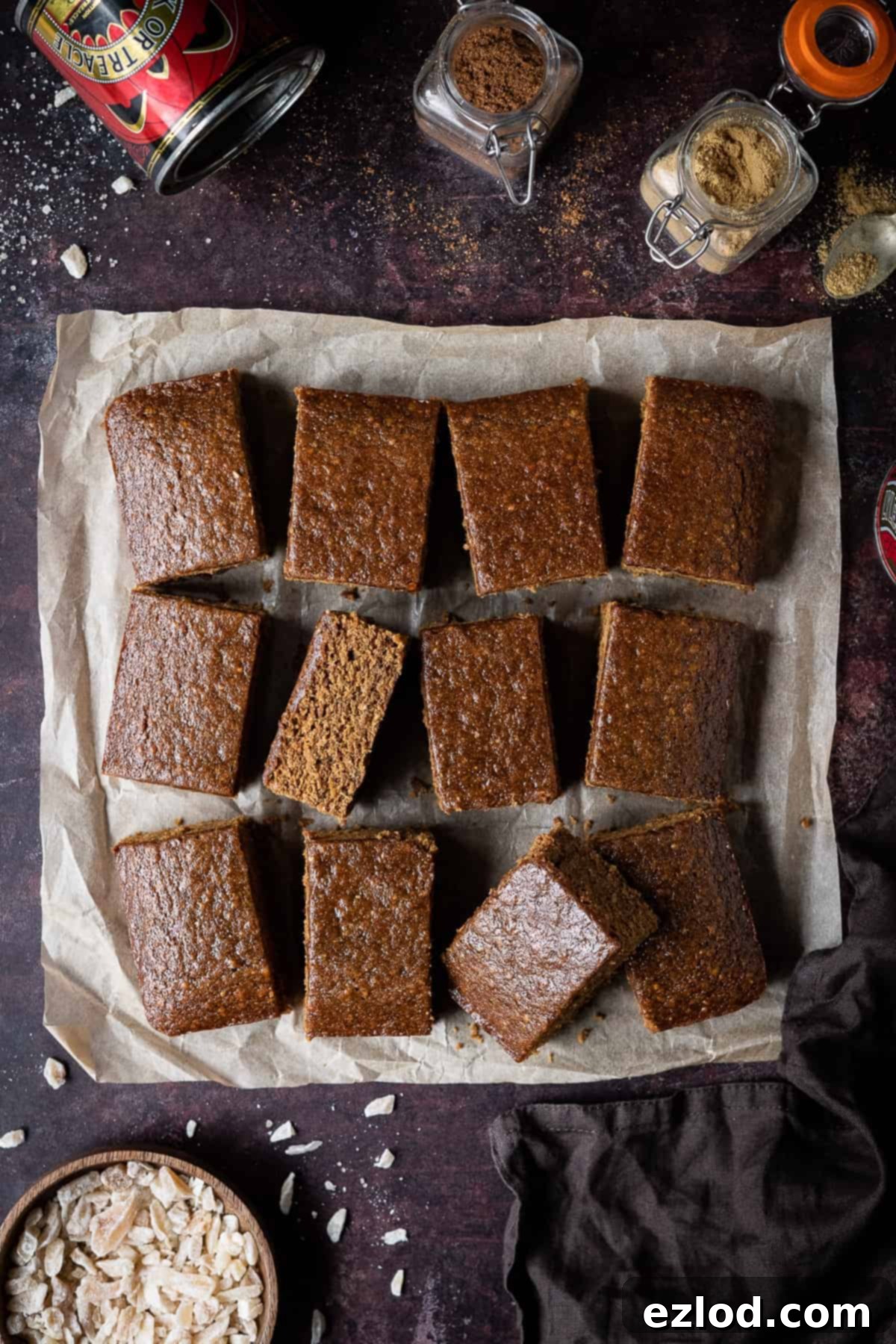
Key Ingredients for the Best Vegan Parkin and Smart Substitutions
Crafting the perfect vegan parkin relies on a few core ingredients, each playing a crucial role in achieving its distinctive flavor and texture. Here’s a detailed look at what you’ll need and how to handle any substitutions:
Treacle and Golden Syrup: The Heart of Stickiness
Some traditional parkin recipes call for treacle exclusively, but I find that a harmonious blend of treacle and golden syrup yields the best flavor balance. Using all treacle can be a bit too intense for some palates. You can adjust the ratio to suit your preference, as long as the total amount (280g) remains consistent. While molasses can substitute treacle, there is truly no direct replacement for golden syrup. Its unique buttery caramel notes are irreplaceable. If you can’t find it locally, you might be surprised to learn that it’s possible to make your own golden syrup from scratch!
Brown Sugar: Deepening the Flavor Profile
For this recipe, either dark brown soft sugar or dark muscovado sugar will deliver excellent results. These sugars contribute to the parkin’s moistness and impart a rich, complex caramel flavor that enhances the ginger. While light brown sugar can be used in a pinch, dark varieties are definitely superior for achieving that signature depth of taste.
Vegan Butter: For Structure and Richness
Opt for a high-quality block vegan butter or margarine, rather than the spreadable varieties sold in tubs. Spreadable margarines often have a higher water content, which can negatively impact the final texture of your baked goods. Brands like Naturli Vegan Block or Flora Block are excellent choices. You could also experiment with refined coconut oil, or a 50/50 blend of vegan butter and coconut oil. This blend is an interesting nod to some traditional recipes that used a mix of lard and butter, offering a similar richness and texture.
Oats: The Texture Master
The distinctive chewiness of parkin comes from oats. While fine or medium oatmeal is ideal, there’s no need to buy a special variety. Simply take regular rolled porridge oats and pulse them in a food processor or blender until they are mostly ground, yet still retain some lovely chunky texture. Be careful not to over-blend them into fine oat flour; a coarser grind is what you’re aiming for to achieve that authentic parkin crumb.
Plain Flour: The Foundation
Standard plain (all-purpose) flour works perfectly as the base for this cake, providing structure and stability.
Baking Powder: The Rising Star
During my recipe development, I tested versions with both baking powder and bicarbonate of soda (baking soda) as leavening agents. The baking powder versions consistently produced a better rise and were significantly less prone to sinking in the middle. If baking powder is unavailable, you can substitute 1 teaspoon of bicarbonate of soda, but be aware that your parkin is more likely to develop a slight dip in the center. Rest assured, it will still be incredibly delicious!
Ground Ginger and Mixed Spice: The Warming Aromatics
Parkin should be assertively spicy, so don’t shy away from the ground ginger! We go quite heavy on it here. For an added layer of complexity and warmth, I also include a touch of mixed spice. If you’re outside the UK and mixed spice isn’t readily available, it’s a blend of sweet spices often containing cinnamon, nutmeg, and cloves. You can easily substitute it with pumpkin spice or create your own blend using these common warming spices.
Non-Dairy Milk: The Egg Replacement
Unsweetened soy milk is my top recommendation for baking, as its higher protein content makes it an excellent egg substitute, contributing to the cake’s structure and moisture. However, any variety of unsweetened non-dairy milk will work. Opt for unsweetened if possible, as this cake already has a good amount of sugar.
Salt: The Flavor Enhancer
A good pinch of salt is vital; it balances the sweetness of the syrups and sugars, allowing the nuanced spice flavors to truly shine.
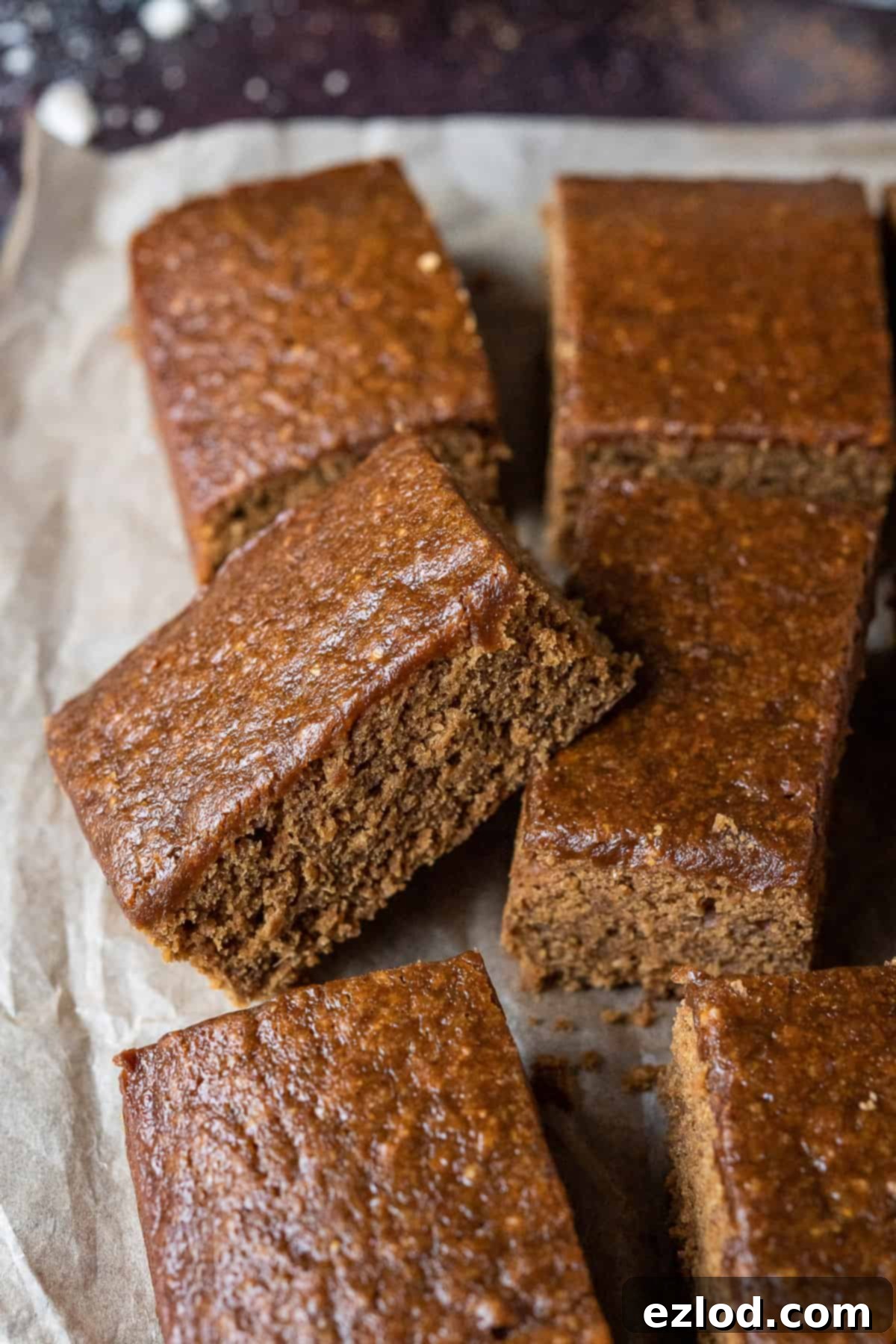
How To Make Irresistible Vegan Parkin: A Step-by-Step Guide
(For precise measurements and full detailed instructions, please refer to the comprehensive recipe card provided below.)
First, prepare your oats. If using rolled porridge oats, simply pulse them in a food processor or blender until they are coarsely ground. They should be chopped but still retain some textural chunks – avoid turning them into fine flour. The image below illustrates the ideal consistency.
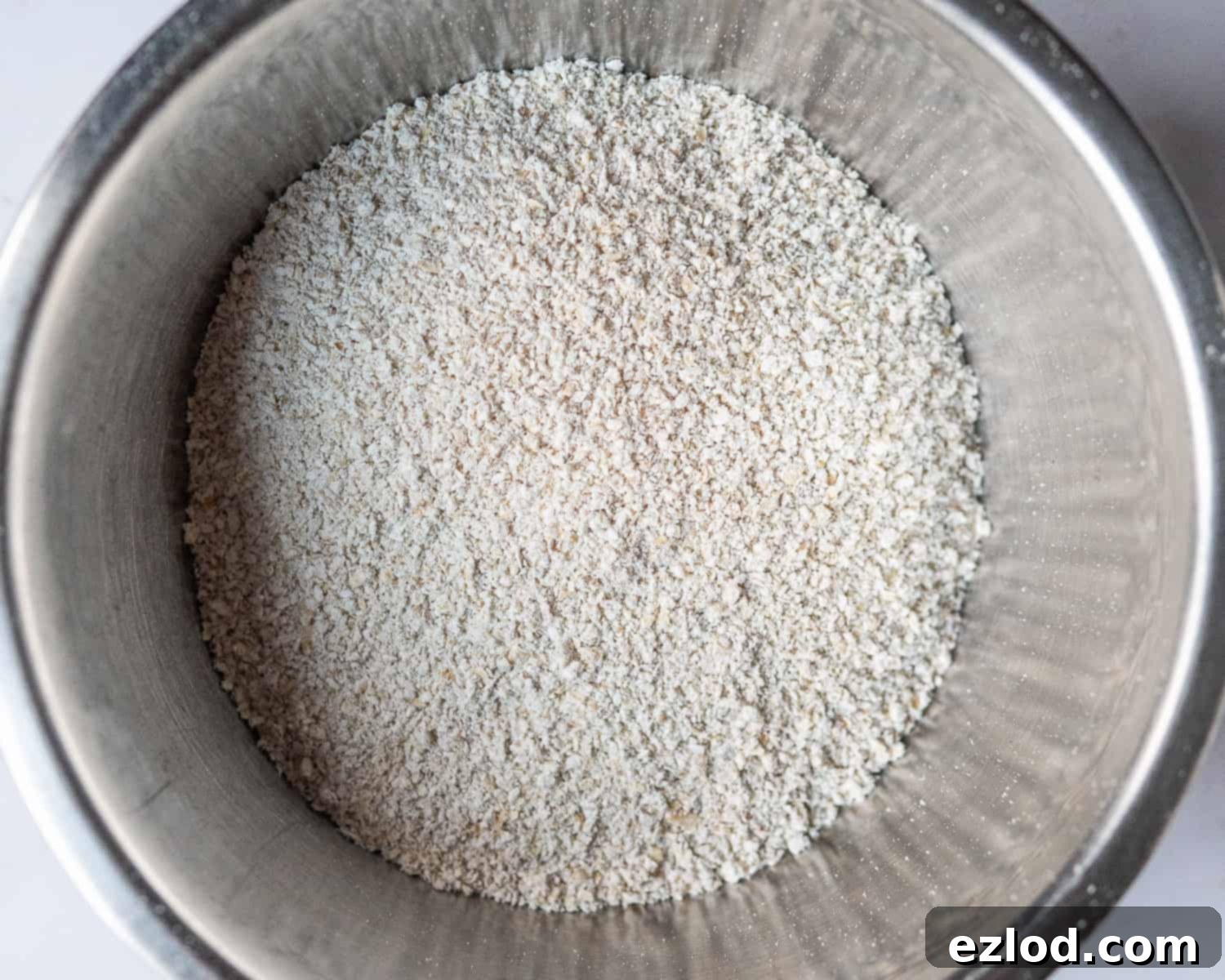
Combine these ground oats in a large mixing bowl with the plain flour, baking powder, generous amounts of ground ginger, mixed spice, and a pinch of salt. Whisk these dry ingredients thoroughly until they are evenly distributed.
In a separate saucepan, gently melt together the dark brown sugar (or muscovado), golden syrup, treacle, and vegan butter over a low heat. Stir continuously until the mixture is smooth and fully combined, being careful not to let it boil.
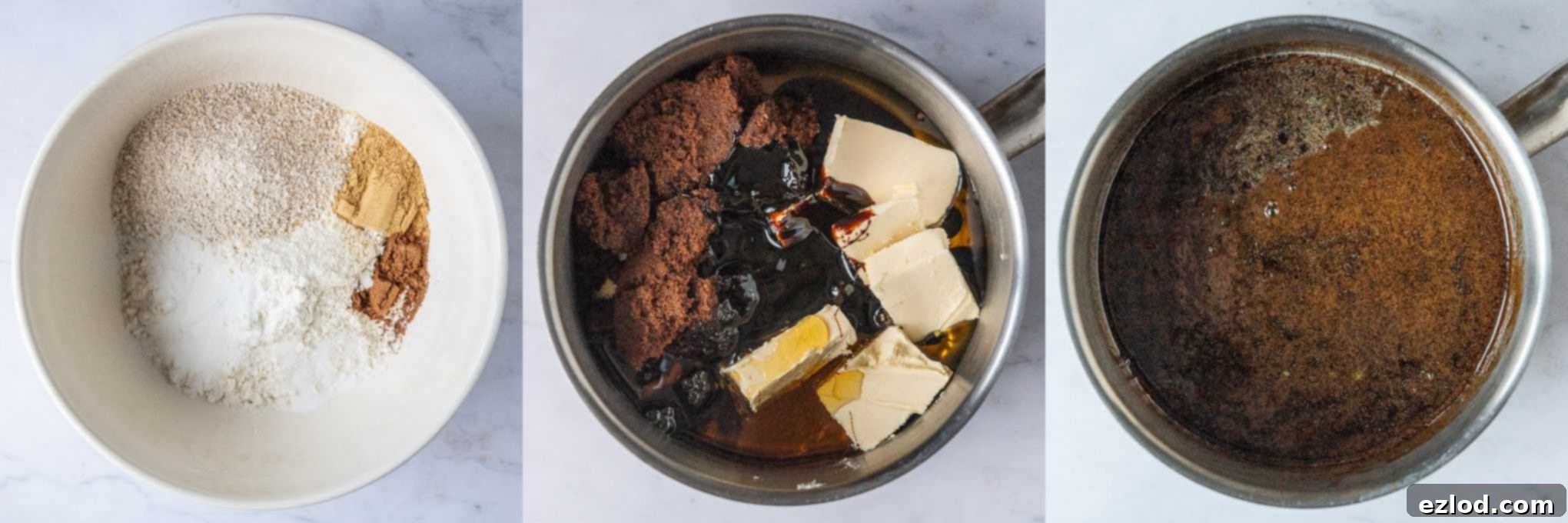
Pour this warm, aromatic syrup mixture into the bowl containing your dry ingredients. Next, pour a little non-dairy milk into the now-empty saucepan and give it a quick swirl to pick up any delicious, sticky residue clinging to the bottom. This ensures no flavor goes to waste and helps clean the pan! (This step is optional but highly recommended).
Add the milk from the saucepan to your main mixing bowl and stir everything together until all dry lumps disappear and you have a smooth, if not particularly attractive, batter. Don’t worry about its appearance at this stage; its baked taste will be absolutely delightful, trust me!
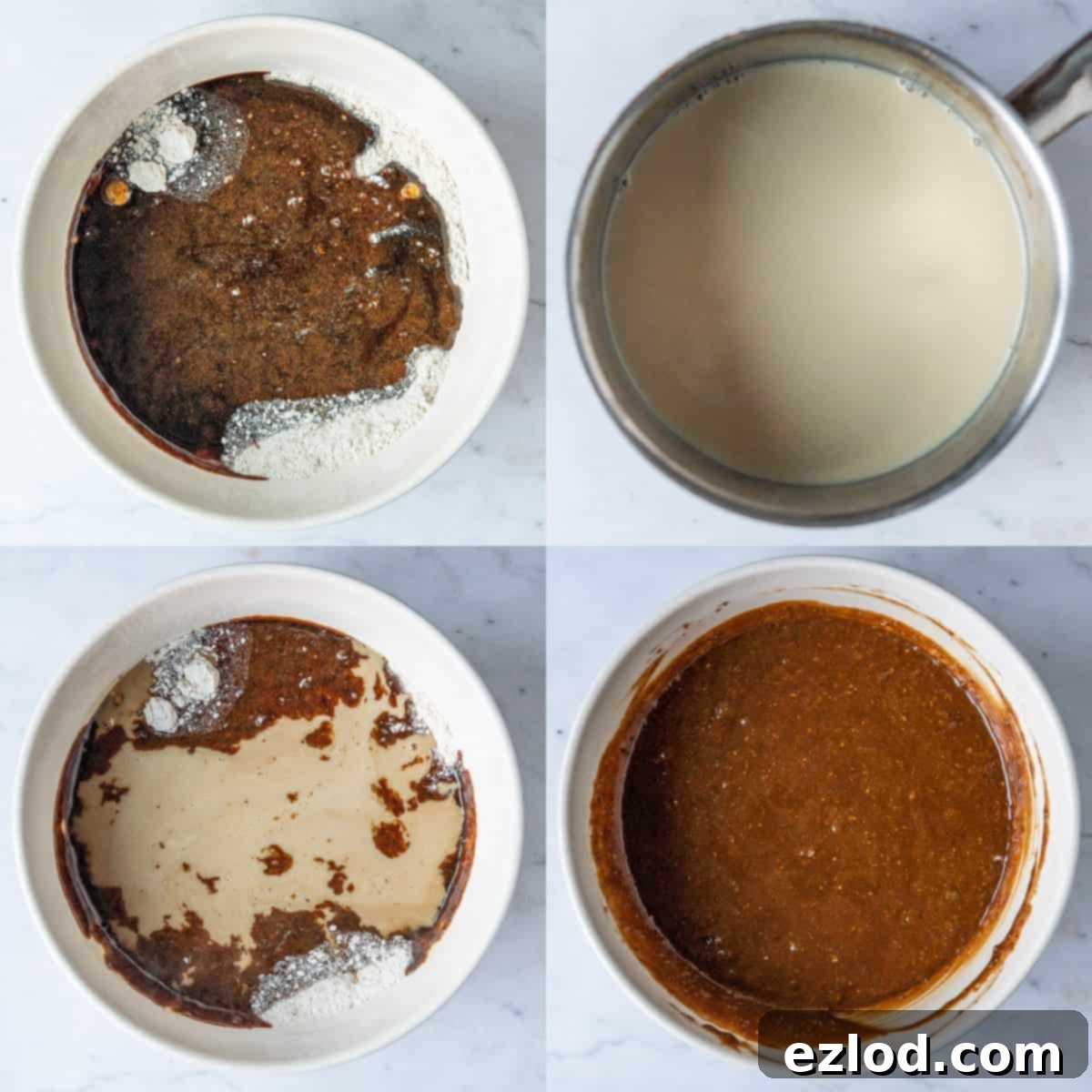
Transfer the prepared batter into a greased and parchment-lined 23cm (9-inch) square cake tin, spreading it evenly. Bake for approximately 30 minutes, or until the top feels firm to the touch and a skewer inserted into the center comes out clean. This indicates it’s perfectly cooked through.
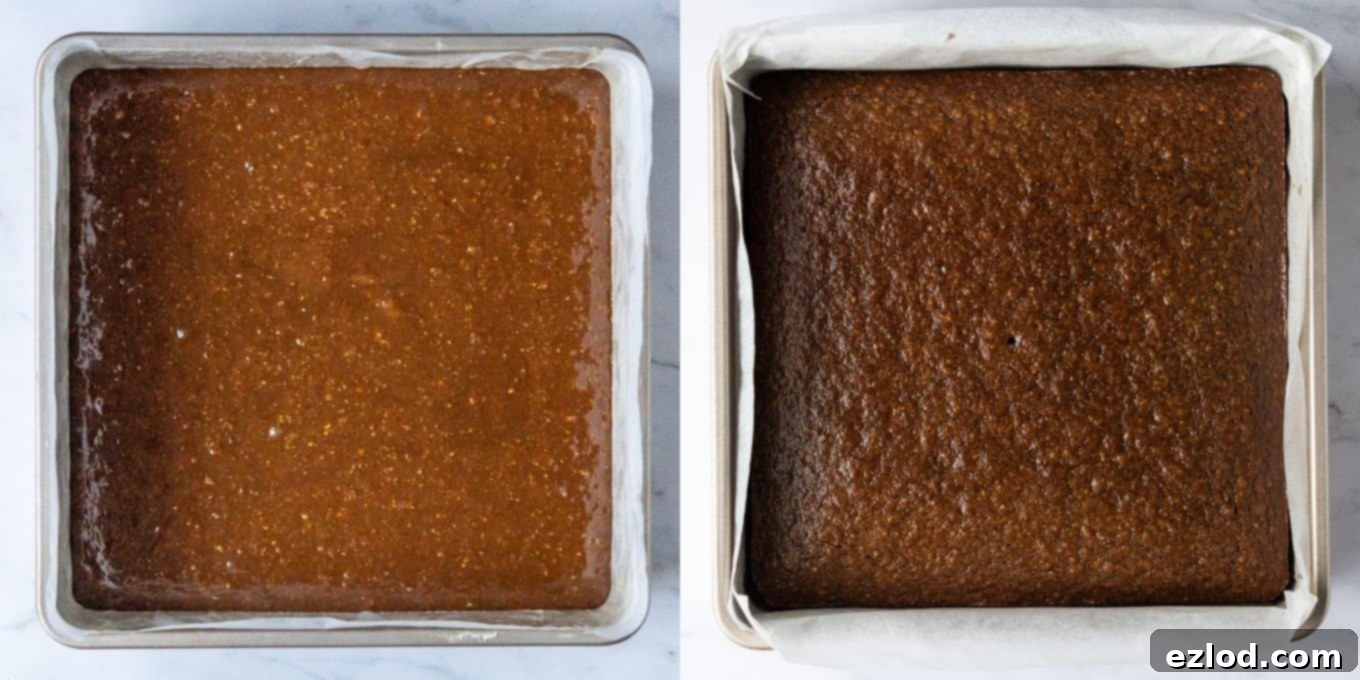
Once your parkin has cooled completely in the tin, it’s ready to be sliced and enjoyed immediately. For an even more traditional experience, transfer it to an airtight container and store it for a few days to allow its flavors to deepen and its texture to become wonderfully sticky. It will keep well for up to two weeks, developing more character with time.
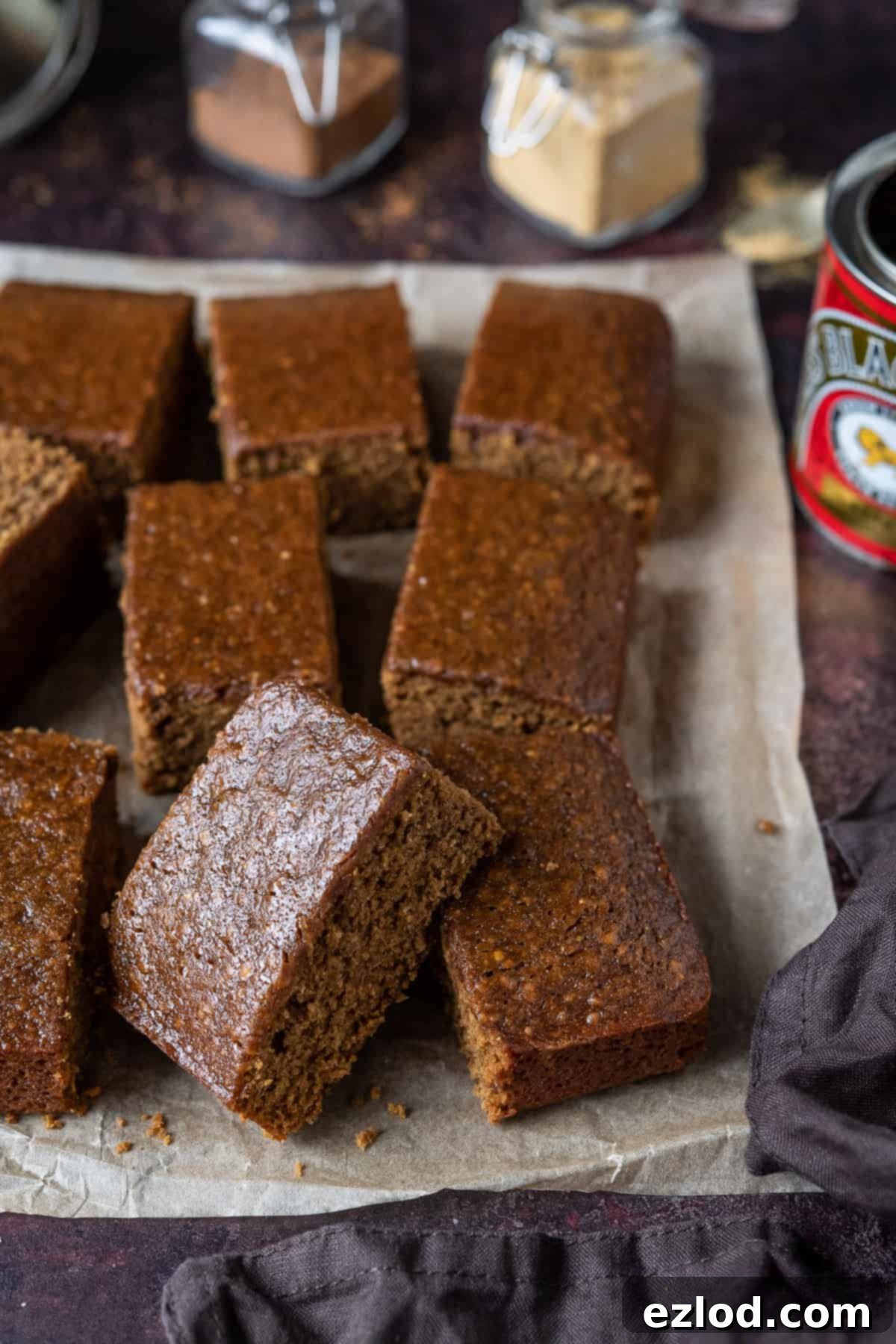
Expert Tips for Baking the Perfect Vegan Parkin
Achieving a truly outstanding vegan parkin is simple with a few insider tips:
- Precision is Key: For the most consistent and delicious results, always follow the recipe closely. I strongly advocate for using gram measurements with a digital kitchen scale over cup conversions. Cup measurements, particularly for ingredients like flour and syrups, can be highly inaccurate in baking and may compromise the final outcome.
- Perfectly Ground Oats: Remember the trick for the oats – pulse rolled porridge oats in a food processor or blender until they are mostly ground but still have some chunky texture. The goal is to avoid fine oat flour, which would change the cake’s density. Refer to the photo in the “How To Make” section for the ideal texture.
- Don’t Skimp on Sugar: Parkin’s signature moistness, incredible stickiness, and rich flavor come from its sugar and syrup content. Do not attempt to reduce these amounts; doing so will alter the texture and taste significantly, leading to a drier, less authentic cake.
- Weigh Your Syrups: Golden syrup and treacle are dense and extremely difficult to measure accurately in cups, leading to potential inconsistencies. Weighing them precisely in grams is crucial. Being too heavy-handed with these liquid sweeteners can cause the parkin to sink or become excessively sticky.
- Boost the Ginger Kick: For those who adore a bolder ginger flavor, stir a large handful of finely chopped candied ginger or stem ginger into the batter just before baking. This adds delightful bursts of warmth and chewiness.
- Patience for Perfection: Unlike some parkin recipes that require a week of storage before they are palatable, this vegan parkin is delicious straight from the oven. However, its flavors truly deepen and its characteristic sticky, chewy texture develops further after a few days of storage in an airtight container. It will keep beautifully for one to two weeks, becoming even more irresistible with time.
- Serving Suggestions: While fantastic on its own, parkin is also wonderful served with a dollop of vegan custard, a scoop of vanilla vegan ice cream, or simply with a comforting cup of tea or coffee. It’s also a delightful addition to a dessert platter.
Storage and Freezing Your Vegan Parkin
Proper storage ensures your vegan parkin remains fresh and delicious:
- Storage: Once completely cooled, store the parkin in an airtight container at room temperature. It will keep for up to two weeks, becoming stickier and more flavorful with each passing day.
- Freezing: Yes, parkin freezes beautifully! Once cooled, wrap it tightly in plastic wrap and then in aluminum foil, either as a whole cake or in individual slices. Freeze for up to three months. To enjoy, thaw at room temperature.
Frequently Asked Questions About Vegan Parkin
- Can I make this parkin gluten-free?
- While oats are naturally gluten-free, ensure you use certified gluten-free rolled oats and a gluten-free all-purpose flour blend (one designed for baking, not just bread). The texture might vary slightly, but it should still be delicious.
- What if my parkin sinks in the middle?
- If you used baking soda instead of baking powder, this is a common occurrence. Also, too much syrup (if not weighed accurately) or opening the oven door too early can cause sinking. It will still taste great!
- How do I get the parkin to be extra sticky?
- The stickiness develops over time. Storing the parkin in an airtight container for a few days after baking will allow the molasses and golden syrup to migrate through the cake, creating that desirable sticky texture.
- Can I add dried fruit or nuts?
- Absolutely! A handful of sultanas, raisins, or chopped pecans/walnuts would make a lovely addition to the batter. Just toss them in flour before adding to prevent them from sinking.
More Delicious Vegan Ginger Recipes to Try:
- Easy vegan ginger cake
- Gingerbread cinnamon rolls
- Vegan gingerbread cookies
- Ginger apple pie
- Vegan ginger bundt cake
- No-bake vegan chocolate ginger tart
- Pear and ginger jam
- Thick, creamy vegan gingerbread hot chocolate
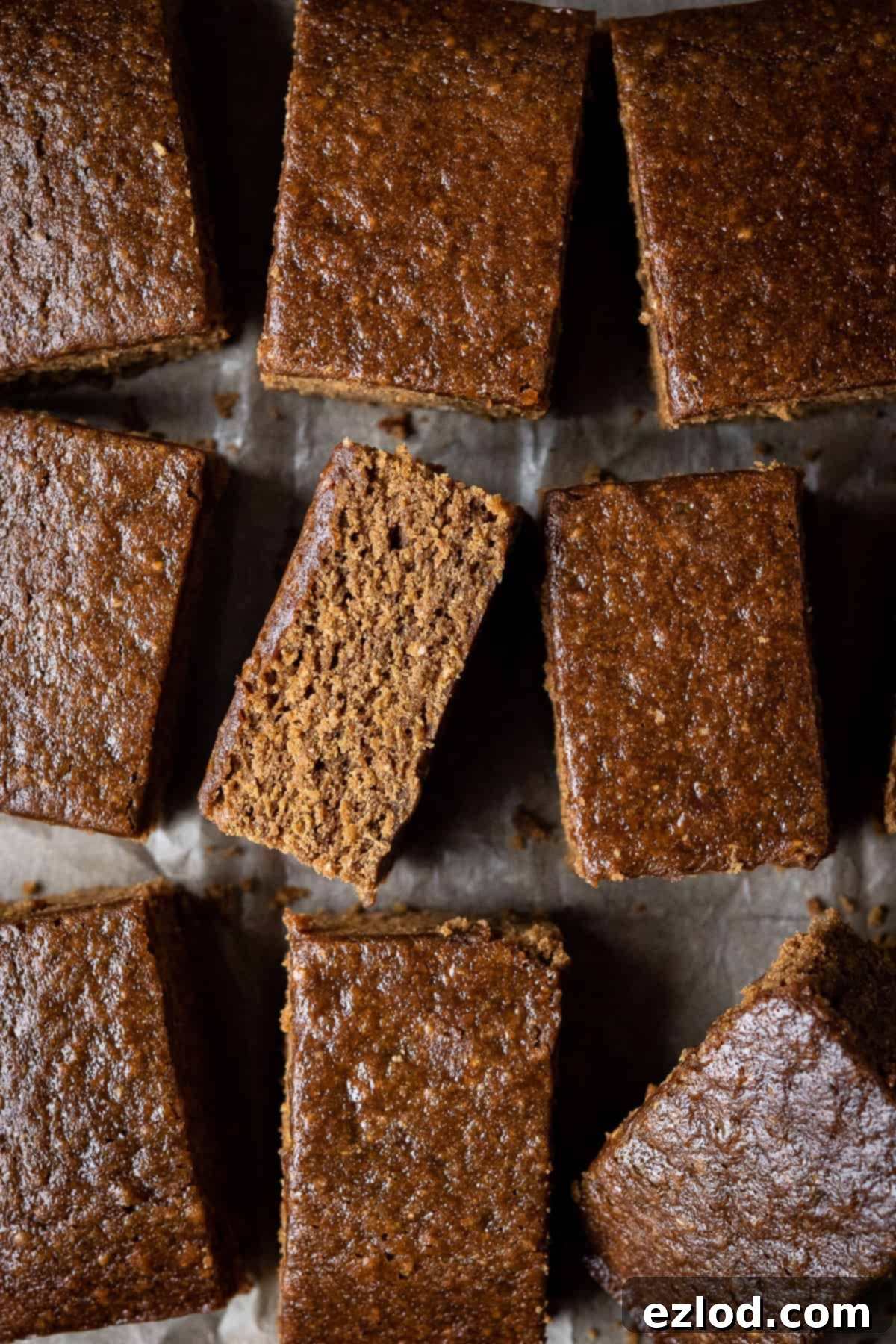
If you’ve given this delightful vegan parkin recipe a try, please let me know how it turned out! I’d love to hear your thoughts – rate the recipe, leave a comment below, or tag @domestic_gothess on Instagram and use the hashtag #domesticgothess to share your creations!
*All images and content on Domestic Gothess are copyright protected. If you wish to share this recipe, please do so by using the provided share buttons. Please do not screenshot, repost the full recipe, or reproduce content in its entirety.*

Print
Vegan Parkin
Ingredients
- 100 g (3 ½ oz) roughly ground porridge oats* (or medium oatmeal for best texture)
- 250 g (2 cups) plain (all-purpose) flour
- 2 ½ tsp baking powder
- 3 ½ tsp ground ginger
- 1 tsp mixed spice (or pumpkin spice blend)
- a good pinch of salt
- 200 g (1 cup) dark brown soft sugar or dark muscovado sugar
- 130 g (4 ½ oz / ½ cup + 1 Tbsp) vegan block butter/margarine
- 180 g (6 ⅓ oz / ½ cup + 1 Tbsp) golden syrup
- 100 g (3 ½ oz / ¼ cup + 1 Tbsp) treacle (or rich molasses)
- 160 ml (⅔ cup) unsweetened non-dairy milk (soy milk is recommended)
Instructions
-
Preheat your oven to 180°C/160°C fan/350°F/gas mark 4. Lightly grease a 23cm / 9-inch square cake tin and line it with baking parchment.
-
In a large bowl, whisk together the ground oats/oatmeal, plain flour, baking powder, ground ginger, mixed spice, and salt until all dry ingredients are thoroughly combined.
-
In a saucepan over a low heat, combine the dark brown sugar, vegan butter, golden syrup, and treacle. Cook, stirring frequently, until the mixture is completely melted and smooth. Ensure it doesn’t come to a boil.
-
Pour the warm syrup mixture into the bowl containing the dry ingredients. Pour the non-dairy milk into the now-empty saucepan and stir it around to loosen and incorporate any remaining sticky syrup bits.
-
Add the milk from the saucepan to the bowl with the other ingredients. Stir everything together until a smooth batter forms and no dry lumps are visible.
-
Pour the batter into your prepared cake tin and spread it evenly with a spatula. Bake for approximately 30 minutes, or until the top is firm to the touch and a skewer inserted into the center comes out clean.
-
Allow the parkin to cool completely in the tin before carefully removing, slicing into bars, and storing in an airtight container to develop its perfect sticky texture.
Notes
- For the absolute best results, precision is key! Always follow the gram measurements (using a digital scale) rather than relying on cup conversions. Cup measurements can be inconsistent and may affect your baking outcomes.
- *For the ground oats, take regular rolled porridge oats and pulse them in a food processor or blender. Aim for a texture that is mostly ground but still retains some small chunks; avoid blending them too finely into oat flour. Refer to the image within the blog post for an example of the ideal texture.
- For a truly enhanced ginger flavor, consider stirring in a handful of finely chopped candied ginger or stem ginger into the batter just before baking. This adds delightful pockets of intense warmth and a lovely chew.
